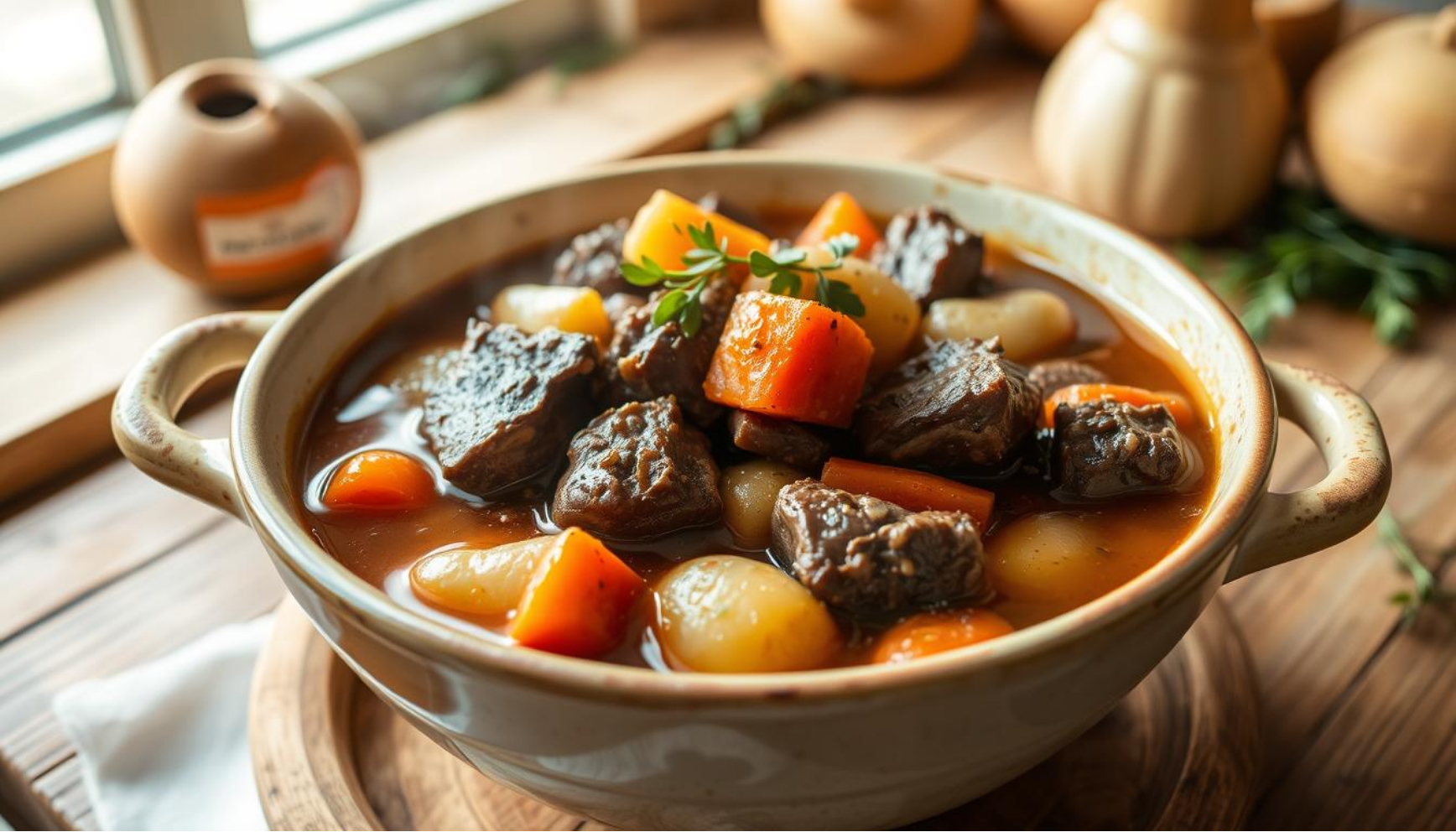Winter’s chill brings a perfect time for a warm, comforting bowl of beef stew. It’s filled with tender meat and tasty root vegetables. This classic dish is a favorite in many American homes, offering rich flavors and a cozy texture.
This recipe will show you how to make a delicious beef stew. It highlights the sweetness and earthy taste of root vegetables. It’s perfect for a cozy dinner or a big family meal, warming your heart and pleasing your taste buds.
A steaming bowl of hearty beef stew, rich brown broth filled with tender pieces of beef, carrots, potatoes, and parsnips, garnished with fresh herbs, rustic wooden table setting, cozy kitchen atmosphere, soft natural lighting.
Key Takeaways
- Hearty, comforting beef stew perfect for cold weather
- Features tender beef and an array of flavorful root vegetables
- Easy to prepare, with a slow-cooked, rich and satisfying texture
- Suitable for both weeknight dinners and special occasions
- Delivers a balance of savory and natural sweetness
What Makes This Beef Stew Special
This hearty beef stew with root vegetables is a true culinary delight. It offers a perfect blend of nutrient-dense ingredients and mouthwatering flavor profile. The tender meat and seasonal root vegetables make it a comforting dish that will become a family favorite.
The Perfect Comfort Food Combination
The secret to this beef stew’s success is the carefully chosen ingredients. The tender meat is simmered to perfection. This allows the flavors to blend well with the nutrient-dense root vegetables, like carrots, potatoes, and onions.
This blend results in a dish that is both deeply satisfying and nourishing.
Health Benefits of Root Vegetables
- Root vegetables are packed with essential vitamins, minerals, and fiber. They are a nutrient-dense addition to any meal.
- They provide antioxidants and phytonutrients that support overall health and well-being.
- Incorporating these seasonal ingredients into your diet can boost your immune system and promote a balanced, healthy lifestyle.
Why This Recipe Works
This beef stew recipe showcases the power of simple, wholesome ingredients. The mix of tender meat and root vegetables creates a delicious flavor profile. It also ensures each bite is full of essential nutrients and vitamins.
With its perfect balance of comfort and nutrition, this dish is sure to become a go-to meal for any occasion.
Essential Ingredients for Your Root Vegetable Beef Stew
Making a hearty beef stew with root vegetables needs the right ingredients. At its core is the beef chuck, which gives the stew its rich taste. Alongside, carrots, potatoes, and onions add comfort and nutrition.
Adding herbs and broth boosts the flavors. Fresh thyme, rosemary, and bay leaves add aromas. A good beef or vegetable broth deepens the stew’s taste. Garlic and tomato paste also enhance the savory flavor.
A bit of red wine or balsamic vinegar adds acidity. Worcestershire sauce and Dijon mustard bring unique umami tastes.
Choosing and mixing these key ingredients makes a beef stew with root vegetables that’s both comforting and healthy. It’s ideal for cold days when you want a warm, filling meal.
The quality of your ingredients greatly affects your dish. Choose fresh, high-quality produce. Pay attention to the amounts to get the perfect flavor balance.
Kitchen Equipment You’ll Need
Preparing a hearty beef stew with root vegetables requires the right kitchen tools. The ingredients are key, but the right tools can greatly improve your cooking experience and the stew’s taste.
Must-Have Cooking Tools
- A Dutch oven or a large, heavy-bottomed pot with a tight-fitting lid. This is the perfect vessel for simmering the stew and allowing the flavors to meld together.
- A sharp chef’s knife for efficiently dicing the beef and chopping the vegetables.
- A sturdy cutting board to provide a stable surface for your knife work.
- A ladle or large spoon for serving the stew and ensuring every bite is packed with delicious broth.
Optional but Helpful Equipment
While the essentials above are the core tools you’ll need, there are a few additional items that can make the cooking process even easier:
- A slow cooker or Crock-Pot® for hands-off simmering, allowing the stew to develop deep, complex flavors over several hours.
- A meat thermometer to ensure the beef is cooked to the perfect tender texture.
- A vegetable peeler for quickly and efficiently removing the skins from root vegetables like potatoes and carrots.
By gathering these essential and optional tools, you’ll be well-equipped to create a mouthwatering beef stew with root vegetables. This stew will warm the soul and satisfy the taste buds.
Selecting and Preparing the Perfect Cut of Beef
Choosing the right beef cut is key for a hearty stew. Look for a cut that’s well-marbled and tender. Beef chuck is a great choice because it becomes tender and flavorful when cooked right.
Marbling, or the fat in the meat, helps tenderize and moisten the stew. Choose beef chuck with lots of marbling for a tender and juicy stew. Trimming excess fat also helps balance the flavor.
- Opt for beef chuck with a generous amount of marbling for optimal tenderness and flavor.
- Trim any large pieces of fat from the meat to prevent an overly greasy stew.
- Consider tenderizing the beef chuck by pounding it gently with a meat mallet or using a marinade to further enhance its texture.
By choosing and preparing the beef chuck carefully, you’ll make a delicious beef stew. It will warm your soul and please your taste buds.
A close-up view of a raw beef chuck roast, showcasing its marbled texture and rich red color, surrounded by fresh root vegetables like carrots and potatoes, on a rustic wooden cutting board with kitchen tools in the background.

| Cut of Beef | Characteristics | Ideal for Stew |
|---|---|---|
| Beef Chuck | Well-marbled, naturally tender | Yes |
| Beef Brisket | Tough, with a lot of connective tissue | No |
| Beef Sirloin | Lean, can become dry when cooked for a long time | No |
“The secret to a truly exceptional beef stew lies in the quality and preparation of the beef.”
Guide to Root Vegetables Selection
Choosing the right root vegetables is key for a delicious beef stew. These veggies add flavor, nutrition, and texture. Let’s look at the best picks, how to store them, and how to prepare them for your stew.
Best Seasonal Choices
For the best taste and freshness, pick root veggies in season. Here are some top picks:
- Carrots: Sweet, earthy taste and bright color
- Parsnips: Nutty, slightly spicy flavor
- Turnips: Sweet and slightly bitter taste
Storage Tips
To keep your veggies fresh, follow these storage tips:
- Keep carrots, parsnips, and turnips in the fridge. Wrap them in a damp paper towel or use a bag with holes.
- Don’t store them near apples or bananas. These fruits make veggies spoil faster.
- Check your veggies often. Throw away any that are damaged or look off.
Preparation Methods
Here’s how to prep your root veggies for stew:
- Peeling: Use a vegetable peeler to get rid of the tough skin. This makes the veggies smooth.
- Chopping: Cut the veggies into small, even pieces. This helps them cook evenly and look good.
- Roasting: Toss the veggies with oil, salt, and pepper. Roast them in the oven to bring out their sweetness.
By using these tips, you’ll pick and prepare the best root veggies for your stew.
Step-by-Step Cooking Instructions
Making a hearty beef stew with root vegetables is a fun journey. Start by browning the meat to keep its flavors strong. Cook the beef cubes in batches to avoid overcrowding. This way, they get a tasty caramelized crust.
Then, deglaze the pan with a flavorful liquid like broth or wine. This step is key. It makes sure you get all the flavors from the browned bits at the bottom of the pan. This creates a rich base for your stew.
- Add the aromatic onions, garlic, and other veggies like carrots, potatoes, and celery. Cook until they’re soft.
- Put in the spices and herbs. This step is about layering flavors for a perfect mix.
- Pour in the rest of the broth or stock slowly. Make sure to get all the browned bits from the bottom of the pan.
- Let the stew simmer gently. This lets the flavors mix well and the ingredients get tender.
Being patient is important here. The longer it simmers, the deeper the flavors get. Watch it closely and add more liquid if needed to keep the right consistency.
“The true joy of a hearty beef stew lies in the layers of flavors that build with each step of the cooking process.”
By following these steps and using your senses, you’ll make a delicious, comforting beef stew. It will warm your soul and satisfy your taste buds.
A cozy kitchen scene with a bubbling pot of hearty beef stew simmering on the stove, surrounded by fresh root vegetables like carrots, potatoes, and onions. The countertop is adorned with chopping boards and colorful ingredients, while warm, soft lighting enhances the inviting atmosphere. Steam rises from the pot, and a wooden spoon rests nearby.

Hearty Beef Stew with Root Vegetables
Traditional Cooking Method
Our hearty beef stew with root vegetables is a classic comfort food. It’s perfect for satisfying your taste buds. It combines tender beef, nutrient-rich root vegetables, and a savory broth for a wholesome meal.
To start, you’ll need the following ingredients:
- 1 lb. beef stew meat, cut into 1-inch cubes
- 3 medium potatoes, peeled and diced
- 2 carrots, peeled and sliced
- 1 onion, diced
- 2 cloves garlic, minced
- 4 cups beef broth
- 2 tablespoons tomato paste
- 1 teaspoon dried thyme
- Salt and pepper to taste
First, brown the beef in a large pot or Dutch oven over medium-high heat. Remove the beef once it’s seared. Add the onions and garlic, sautéing until fragrant. Then, mix in the tomato paste and beef broth, scraping the pot’s bottom.
Put the beef back in the pot. Add the potatoes, carrots, and thyme. Bring it to a boil, then simmer for 45 minutes to an hour. The vegetables should be tender, and the beef cooked. Season with salt and pepper.
Slow Cooker Variation
For a hands-off option, make this stew in a slow cooker. Add all the ingredients, cover, and cook on low for 7-8 hours or high for 4-5 hours. It’s perfect for meal prep, enjoying all week.
Whether stovetop or slow cooker, this stew will be a family favorite. Serve it alone or with crusty bread for a complete stovetop cooking experience.
Tips for Perfect Seasoning and Flavor Enhancement
Getting the flavors right in a hearty beef stew is an art. It’s all about the right seasoning and techniques. These tips will help you make your stew stand out.
Choosing the right herbs is crucial. Mix fresh and dried herbs like thyme, rosemary, and bay leaves. This mix creates a great aroma and taste. Try adding them at different times to see what works best.
Don’t forget the spices. Spices like cumin, smoked paprika, and cinnamon add a rich flavor. But use them sparingly. A little goes a long way.
- Use herbs and spices to make your stew flavorful.
- Play with when you add herbs to get the best flavor.
- Add umami-rich spices for more depth.
The key to a great beef stew is balancing flavors. With the right seasoning, your stew will be amazing.
“The secret to a delicious beef stew is found in the perfect harmony of herbs, spices, and slow-simmered ingredients.”
Common Mistakes to Avoid
Making a hearty beef stew with root vegetables is a fun cooking adventure. But, it’s key to avoid common mistakes that can ruin the dish. One big mistake is overcooking the meat, making it tough and chewy. To fix this, watch the cooking time closely and use a meat thermometer to check the beef’s doneness.
Another mistake is underseasoning the stew, making it taste bland. Make sure to season the beef and veggies well with herbs and spices. Keep adjusting the seasoning as you cook to get the flavors just right.
Lastly, don’t rush the process. Let the stew simmer slowly so the flavors can blend together. This slow cooking is what makes the stew rich and comforting. Don’t rush it, as it can mess up the texture and flavor.
- Avoid overcooking the meat to prevent it from becoming tough and chewy.
- Ensure proper seasoning to avoid a bland and underwhelming flavor.
- Allow the stew to simmer gently, resisting the urge to rush the cooking process.
“Patience and attention to detail are the keys to creating a truly remarkable beef stew with root vegetables. Embrace the process, and the rewards will be well worth it.”
By avoiding these common mistakes, you can make your beef stew with root vegetables even better. It will become the ultimate comfort food.
Serving Suggestions and Pairings
There are many ways to make your beef stew with root vegetables even better. Try serving it with crusty bread or a glass of red wine. These choices can really make your meal special.
Bread Options
Crusty bread is a classic choice for beef stew. It can be a rustic crusty bread or a fluffy loaf. Either way, it’s great for dipping into the stew’s rich broth.
Wine Recommendations
A bold red wine pairs well with the stew’s strong flavors. Try a full-bodied Cabernet Sauvignon or a smooth Merlot. They both add to the meal’s enjoyment.
Side Dish Ideas
- Creamy mashed potatoes – perfect for soaking up the stew’s flavors
- A simple green salad – adds a fresh touch to the meal
- Roasted root vegetables – brings more flavors and textures to the table
Pairing your beef stew with the right bread, wine, and sides makes a complete meal. It will surely please your taste buds.
| Bread Options | Wine Recommendations | Side Dish Ideas |
|---|---|---|
| Crusty bread | Cabernet Sauvignon, Merlot | Mashed potatoes, Green salad, Roasted root vegetables |
Storage and Reheating Guidelines
Enjoying your homemade beef stew leftovers is easy with the right storage and reheating. Follow these simple guidelines to keep your stew safe and delicious.
For short-term storage, refrigerate the stew in an airtight container for 3-4 days. When reheating, put the stew in a saucepan and warm it over medium heat. Stir occasionally until it’s hot. Don’t microwave it to avoid uneven heating and texture loss.
For longer storage, freeze the stew for up to 3 months. Cool it completely before putting it in a freezer-safe container or bag. Thaw it in the fridge overnight, then reheat it as you would refrigerated leftovers. This keeps flavors and textures intact.





